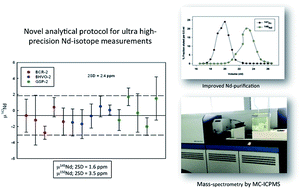Ultra-high-precision Nd-isotope measurements of geological materials by MC-ICPMS
Abstract
We report novel techniques allowing the measurement of Nd-isotope ratios with unprecedented accuracy and precision by multi-collector inductively coupled plasma mass spectrometry. Using the new protocol, we have measured the Nd-isotopic composition of rock and synthetic Nd standards as well as that of the Allende carbonaceous chondrite. Analyses of BCR-2, BHVO-2 and GSP-2 rock standards yield mass-independent compositions identical to the JNdi-1 Nd-reference standard, with an external reproducibility of 2.4, 1.6, 1.6 and 3.5 ppm respectively, on μ142Nd, μ145Nd, μ146Nd and μ150Nd (μ representing the ppm-deviation of the ratios from JNdi-1) using 148Nd/144Nd for internal normalization. This represents an improvement in precision by a factor of 2, 7 and 9 respectively for μ142Nd, μ145Nd and μ150Nd. Near-quantitative recovery from purification chemistry and sample-standard bracketing allow for the determination of mass-dependent Nd-isotopic composition of samples. Synthetic standards, namely La Jolla and AMES, record mass-dependent variability of up to 1.2 ε per atomic mass unit and mass-independent compositions resolvable by up to 3 ppm for μ142Nd and 8 ppm for μ150Nd, relative to JNdi-1. The mass-independent compositions are consistent with equilibrium mass fractionation during purification. The terrestrial rock standards define a uniform stable ε145Nd of −0.24 ± 0.19 (2SD) relative to JNdi-1, indistinguishable from the mean Allende ε145Nd of −0.19 ± 0.09. We consider this value to represent the mass-dependent Nd-isotope composition of Bulk Silicate Earth (BSE). The modest mass-dependent fractionation of JNdi-1 relative to BSE results in potential effects on mass-independent composition that cannot be resolved within the reproducibility of our analyses when correcting for natural and instrumental mass fractionation by kinetic law, making it a suitable reference standard for analysis of unknowns. Analysis of Allende (CV3) carbonaceous chondrite returns an average μ142Nd deficit of −30.1 ± 3.7 ppm in agreement with previous studies. The apparent deficit is, however, lowered to −23.8 ± 4.0 ppm while normalizing to 148Nd/144Nd instead of 146Nd/144Nd. We interpret this as the effect of a possible nucleosynthetic anomaly of –6.3 ± 0.5 ppm in μ146Nd. As 142Nd and 146Nd are both s-process-dominated nuclides, this hints at the possibility that terrestrial μ142Nd excess may not reflect 146Sm decay as widely accepted.


 Please wait while we load your content...
Please wait while we load your content...